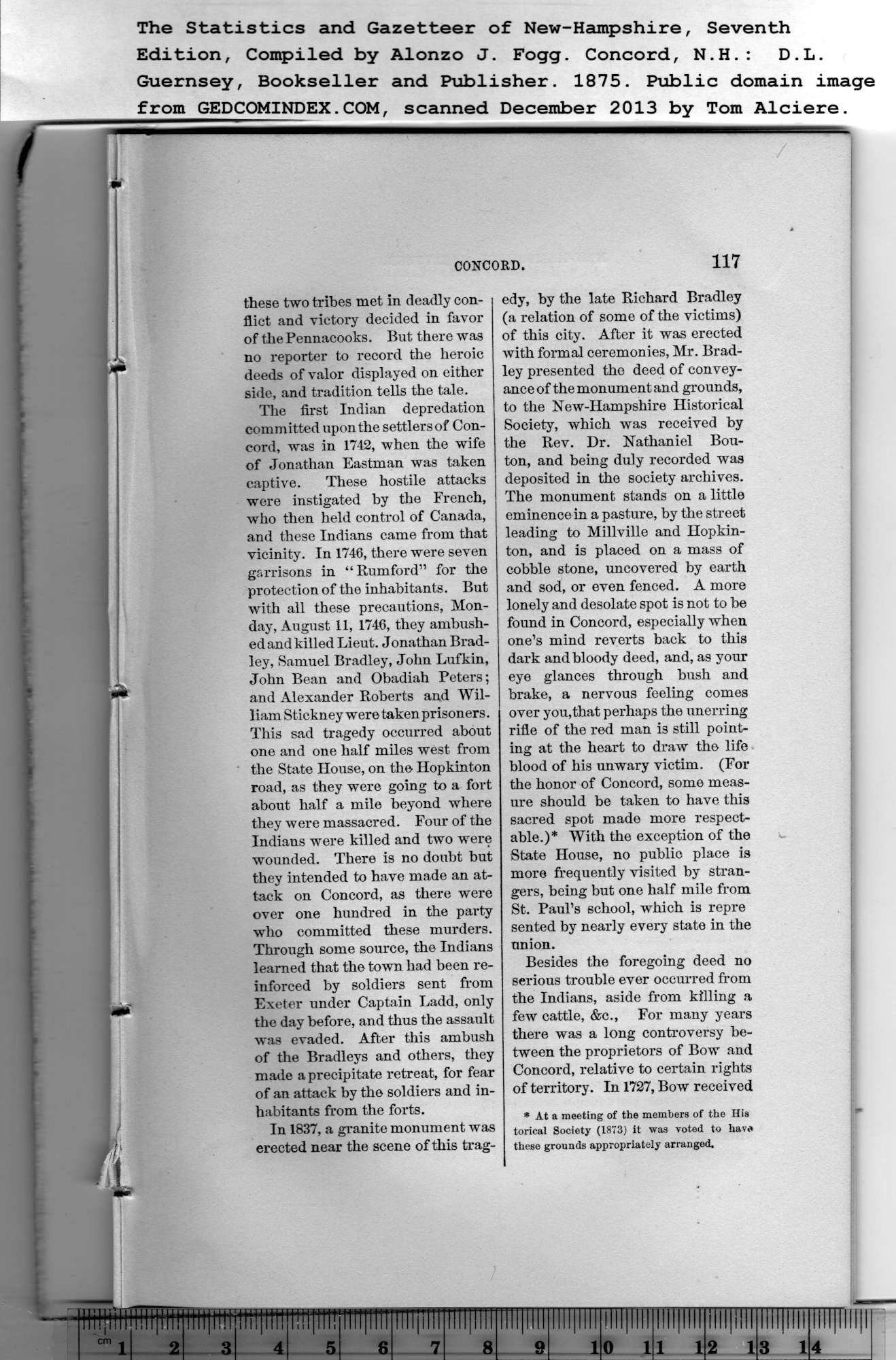|
these two tribes met in deadly con-
flict and victory decided in favor
of the Pennacooks. But there was
no reporter to record the heroic
deeds of valor displayed on either
side, and tradition tells the tale.
The first Indian depredation
committed upon the settlers of Con-
cord, was in 1742, when the wife
of Jonathan Eastman was taken
captive. These hostile attacks
were instigated by the French,
who then held control of Canada,
and these Indians came from that
vicinity. In 1746, there were seven
garrisons in “Rumford” for the
protection of the inhabitants. But
with all these precautions, Mon-
day, August 11, 1746, they ambush-
ed and killed Lieut. Jonathan Brad-
ley, Samuel Bradley, John Lufkin,
John Bean and Obadiah Peters;
and Alexander Roberts and Wil-
liam Stickney were taken prisoners.
This sad tragedy occurred about
one and one half miles west from
the State House, on the Hopkinton
road, as they were going to a fort
about half a mile beyond where
they were massacred. Four of the
Indians were killed and two were
wounded. There is no doubt but
they intended to have made an at-
tack on Concord, as there were
over one hundred in the party
who committed these murders.
Through some source, the Indians
learned that the town had been re-
inforced by soldiers sent from
Exeter under Captain Ladd, only
the day before, and thus the assault
was evaded. After this ambush
of the Bradleys and others, they
made a precipitate retreat, for fear
of an attack by the soldiers and in-
habitants from the forts. |
In 1837, a granite monument was
erected near the scene of this trag-
edy, by the late Richard Bradley
(a relation of some of the victims)
of this city. After it was erected
with formal ceremonies, Mr. Brad-
ley presented the deed of convey-
ance of the monument and grounds,
to the New-Hampshire Historical
Society, which was received by
the Rev. Dr. Nathaniel Bou-
ton, and being duly recorded was
deposited in the society archives.
The monument stands on a little
eminence in a pasture, by the street
leading to Millville and Hopkin-
ton, and is placed on a mass of
cobble stone, uncovered by earth
and sod, or even fenced. A more
lonely and desolate spot is not to be
found in Concord, especially when
one’s mind reverts back to this
dark and bloody deed, and, as your
eye glances through bush and
brake, a nervous feeling comes
over you,that perhaps the unerring
rifle of the red man is still point-
ing at the heart to draw the life
blood of his unwary victim. (For
the honor of Concord, some meas-
ure should be taken to have this
sacred spot made more respect-
able.)* With the exception of the
State House, no public place is
more frequently visited by stran-
gers, being but one half mile from
St. Paul’s school, which is repre
sented by nearly every state in the
union.
Besides the foregoing deed no
serious trouble ever occurred from
the Indians, aside from killing a
few cattle, &c., For many years
there was a long controversy be-
tween the proprietors of Bow and
Concord, relative to certain rights
of territory. In 1727, Bow received
* At a meeting of the members of the His
torical Society (1873) it was voted to have
these grounds appropriately arranged. |
